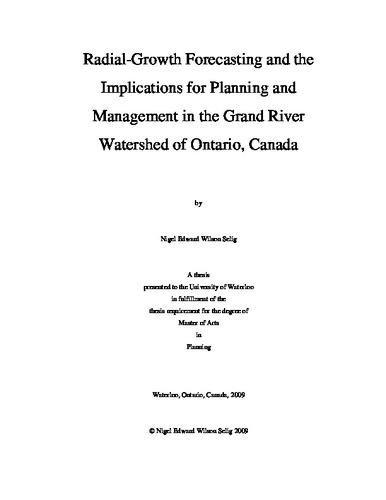| dc.description.abstract | The first objective of this thesis was to predict the future success of selected tree species under low (B1, 550 CO2 ppm) and moderate (A1B, 720 CO2 ppm) climate change scenarios as defined in the Special Report on Emissions Scenarios (SRES). This was accomplished through the creation of radial-growth forecasts for eastern hemlock (Tsuga Canadensis (L.) Carr.), sugar maple (Acer saccharum L.), white spruce (Picea glauca (Moench.) Voss), and white pine (Pinus strobus L.) in the Grand River Watershed of Ontario, Canada. The forecasts were founded on historic growth-climate relationships between standardized regional dendrochronologies for each species and past climate data from the Guelph OAC weather station. These species-specific growth-climate relationships were then extended to 2100 using modeled climate data from the Third Generation Coupled Global Climate Model (CGCM3) to project radial-growth under both emissions scenarios. Results indicated that eastern hemlock radial-growth will remain stable throughout the 21st-century, sugar maple and white spruce growth will start to decline, and white pine growth will increase. While the radial-growth forecasts were limited by the length of the past climate data, the accuracy of the modeled climate data, and the number and type of variables used in the forecast model, the results were statically significant and strongly supported in the literature.
The second thesis objective was to assess the potential impact of the radial-growth forecasts on environmental planning policy and forest management strategy in the Grand River Watershed. Examples of how the forecasts could influence basic management strategies in the watershed were provided to display the conceptual linkages between the results and policy formulation. Next, the radial-growth forecasts were presented to four forest managers working in the watershed to gage the practical implications, perceptions and limitations of the radial-growth forecasting method. While the managers found the radial-growth forecasts interesting, they also noted that the results were of limited use since they could not account for other factors important to the future success of the study species, such as seedling dispersal and establishment rates, as well as the potential effects of pathogens, insects and invasive species. Therefore, it was recommended that future research should work to extrapolate the results of the radial-growth forecasts to other tree species and types in the region, as well as incorporate more variables into the models, so that more accurate and applicable growth projections could be constructed in the watershed. | en |

